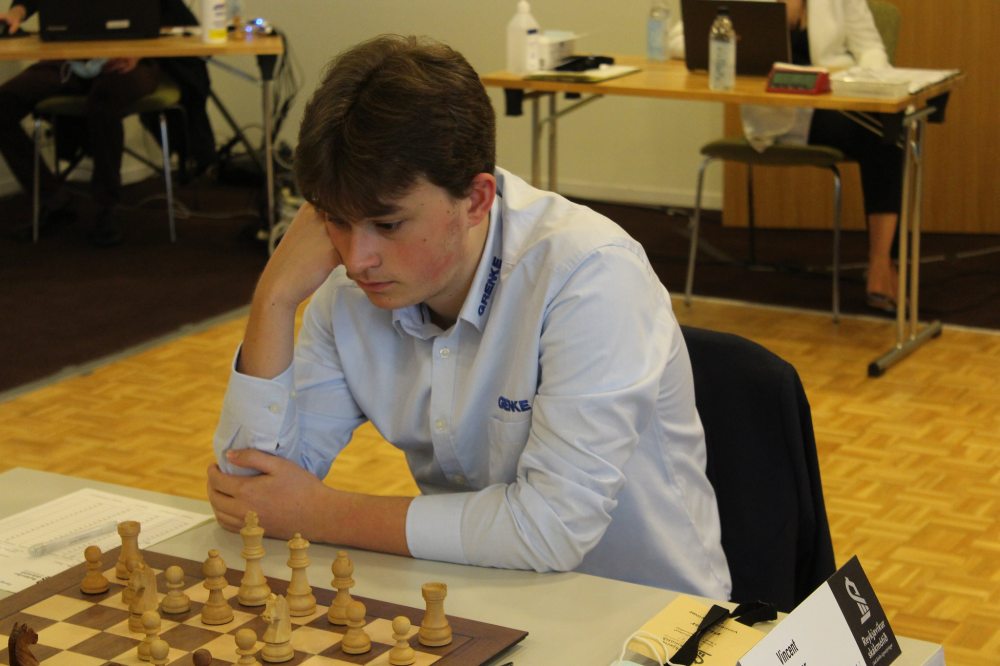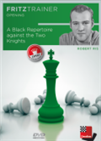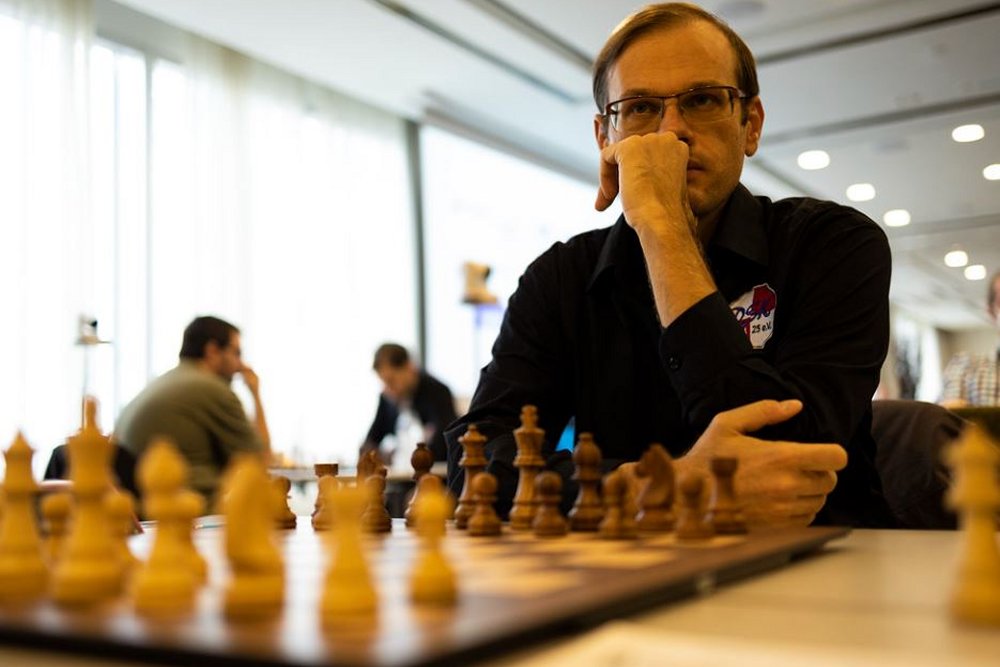Demchenko is the new European Champion
The 2021 European Championship was hosted by the Icelandic Chess Federation and took place in Reykjavík. Traditionally, the competition is played as an open event, with a large number of participants. Unlike the World Championship match, which is played as a 1 vs 1 duel, the European Championship is a massive event with hundreds of participants.
 There are few names which, like that of Alexei Shirov, can be associated with fantastically imaginative and tactically influenced play. Now the Latvian grandmaster is presenting a DVD on precisely that element of the game of chess. And one that is completely based on his own games.
There are few names which, like that of Alexei Shirov, can be associated with fantastically imaginative and tactically influenced play. Now the Latvian grandmaster is presenting a DVD on precisely that element of the game of chess. And one that is completely based on his own games.Since the Swiss teacher Julius Müller developed a pairing system for chess tournaments with large numbers of participants in 1895 — the ‘Swiss System’ — not much progress has been made in this field during 125 years of chess history. With 180 participants, as in Reykjavík, 11 rounds — in other open tournaments only 7 or 9 rounds are played — are too few to ensure a fair ranking.
The first, second and sometimes third tiebreak criteria decide the final rank in case of a tie. This factor turns out to be crucial when it comes to prizes or qualifications. The tiebreak criteria sometimes create curious situations: in some recent Chess Olympiads, it was not clear who had won gold even after the top matches had ended, as the top teams had to wait for some match in the lower boards to end.
Perhaps a different format could be considered when awarding the title of European Champion. But maybe everything is fine the way it is.
The 2021 European Championship in Iceland was still overshadowed by the ongoing coronavirus pandemic. Many potential participants could not — due to travel regulations — or did not want to play.
More important for many players than the fight for the European title was certainly the possibility to get one of 23 qualification places in the next World Cup, simply because the chances were statistically greater. Among the top 23 in the end, the most represented country was Germany, with 5 qualified players.
Vincent Keymer, the greatest German talent, has great potential for development, but his development was and is severely limited by the pandemic and the many cancelled tournaments. At the European Championship, the 16-year-old showed what he is made of. Keymer, the 32nd seeded, played his way to the top of the standings.
In the penultimate round, he failed to make the most of a superior position against Anton Demchenko. However, in the final round, Keymer benefited from a miscalculation by Daniele Vocaturo in a drawn position and caught up with Demchenko. The tiebreak score was the deciding factor which gave the Russian GM overall victory.
 The name Emanuel Lasker will always be linked with his incredible 27 years reign on the throne of world chess. In 1894, at the age of 25, he had already won the world title from Wilhelm Steinitz and his record number of years on the throne did not end till 1921 when Lasker had to accept the superiority of Jose Raul Capablanca. But not only had the only German world champion so far seen off all challengers for many years, he had also won the greatest tournaments of his age, sometimes with an enormous lead. The fascinating question is, how did he manage that?
The name Emanuel Lasker will always be linked with his incredible 27 years reign on the throne of world chess. In 1894, at the age of 25, he had already won the world title from Wilhelm Steinitz and his record number of years on the throne did not end till 1921 when Lasker had to accept the superiority of Jose Raul Capablanca. But not only had the only German world champion so far seen off all challengers for many years, he had also won the greatest tournaments of his age, sometimes with an enormous lead. The fascinating question is, how did he manage that?
Vincent Keymer
Keymer, Vincent (2602) - Vocaturo, Daniele (2630)
European Ch. 2021, Reykjavík ISL (11.2), 05.09.2021
1.Nf3 Nf6 2.c4 e6 3.b3 d5 4.Bb2 Be7 5.e3 0–0 6.Nc3 c5 7.cxd5 exd5 8.d4 Nc6 9.Be2 Ne4 10.dxc5 Qa5 11.Rc1 Bf6 12.Nd4 Nxc5 [Keymer had already played this opening recently: 12...Nxc3 13.Bxc3 Qxc5 14.0–0 Qe7 15.Bf3 Rd8 16.Nxc6 bxc6 17.Ba5 1–0 (38) Keymer,V (2591)-Motylev,A (2641) Chess.com INT 2021]
13.Nxc6 bxc6 14.0–0 Ne4 15.Qc2 Nxc3 16.Bxc3 Bxc3 17.Qxc3 Qxa2 18.Rc2 Qa3 19.Ra1 Qe7 20.Qxc6 Be6
21.Qc5 [21.Rd2 Qb4 22.Rd3 Rfc8 23.Qa6= 1–0 (103) So,W (2770)-Duda,J (2743) chess24.com INT 2021]
21...Qxc5 22.Rxc5 Rfd8 23.b4 d4 24.exd4 Rxd4 25.b5 Rd2 26.Bf3 Rad8 27.h3 R2d7 28.Rc3 Bd5 29.Bg4 Be6 30.Be2 Rd2 31.Bf3 Rb2 [31...R2d7?! 32.Rca3 grabbing the a-pawn.]
32.Bc6 g6 33.Rxa7 Rd1+ 34.Kh2
 With the Traxler Variation (4.Ng5 Bc5!?) spearheading their repertoire, any player should look forward to fighting for the initiative against the Two Knights with Black
With the Traxler Variation (4.Ng5 Bc5!?) spearheading their repertoire, any player should look forward to fighting for the initiative against the Two Knights with Black
34...Rxf2? [After 34...Kg7 it is not easy to make use of the passed pawn, e.g. 35.Ra6 (35.Kg3 h5 36.h4 Rd4=) 35...Rxf2 36.b6 Bd5 37.Bxd5 Rxd5 38.Rb3 Rg5 39.Rg3 Rb5]
35.b6 Rb2 36.b7 Kg7 37.Rc5 Black had probably overlooked this manoeuvre in his calculation. There is a threat of Bb5 or Rb5.
37...Rdb1 38.Be4 Rd1 39.Raa5 Bd7 [Or 39...Rd8 40.Rcb5 Rxb5 41.Rxb5 Rb8 and now simply 42.Kg3 and, for example: (42.Ra5 Bc8 43.bxc8Q Rxc8 offers Black better chances of getting counterplay.) 42...Kf6 43.Kf4 Ke7 44.Ra5 Kd6 45.Kg5 and wins.] 40.Tab5 1–0
A great tournament performance by Keymer, who will gain about 20 Elo points thanks to his rating performance of 2751.
Anton Demchenko was by no means the favourite to win the tournament, and actually became the first sub-2600 player to earn the title — the Russian did have a peak rating of 2679, however. His victory is certainly more than deserved.
A number of young players gained a spot in the next World Cup: besides Keymer (16 years old), Bogdan-Daniel Deac (19), Velimir Ivic (19) and Jonas Buhl Bjerre (17) also qualified.
Final standings
| 1 |
33 |
|
GM |
Demchenko Anton |
|
|
|
|
2597 |
8,5 |
2617 |
72,5 |
77,5 |
2786 |
10 |
28,7 |
| 2 |
32 |
|
GM |
Keymer Vincent |
U18 |
|
|
|
2602 |
8,5 |
2577 |
71,0 |
76,5 |
2751 |
10 |
22,5 |
| 3 |
12 |
|
GM |
Sarana Alexey |
|
|
|
|
2643 |
8,0 |
2592 |
75,5 |
80,5 |
2743 |
10 |
14,3 |
| 4 |
13 |
|
GM |
Deac Bogdan-Daniel |
U20 |
|
|
|
2639 |
8,0 |
2510 |
65,5 |
71,0 |
2666 |
10 |
4,3 |
| 5 |
29 |
|
GM |
Piorun Kacper |
|
|
ACP |
|
2608 |
7,5 |
2605 |
71,5 |
75,5 |
2701 |
10 |
15,5 |
| 6 |
10 |
|
GM |
Mamedov Rauf |
|
|
|
|
2654 |
7,5 |
2599 |
72,0 |
77,5 |
2711 |
10 |
9,1 |
| 7 |
26 |
|
GM |
Erdos Viktor |
|
|
ACP |
|
2614 |
7,5 |
2593 |
69,0 |
74,0 |
2691 |
10 |
13,0 |
| 8 |
36 |
|
GM |
Huschenbeth Niclas |
|
|
|
|
2592 |
7,5 |
2590 |
68,0 |
73,0 |
2683 |
10 |
15,5 |
| 9 |
3 |
|
GM |
Navara David |
|
|
ACP |
|
2675 |
7,5 |
2577 |
71,0 |
75,0 |
2695 |
10 |
3,5 |
| 10 |
47 |
|
GM |
Sanal Vahap |
|
|
|
|
2557 |
7,5 |
2572 |
68,5 |
72,5 |
2658 |
10 |
18,0 |
| 11 |
4 |
|
GM |
Bluebaum Matthias |
|
|
|
|
2674 |
7,5 |
2556 |
66,5 |
71,5 |
2675 |
10 |
0,8 |
| 12 |
18 |
|
GM |
Vocaturo Daniele |
|
|
|
|
2630 |
7,5 |
2554 |
65,5 |
70,5 |
2663 |
10 |
5,9 |
| 13 |
30 |
|
GM |
Antipov Mikhail Al. |
|
|
|
|
2607 |
7,5 |
2547 |
69,0 |
74,5 |
2647 |
10 |
7,7 |
| 14 |
44 |
|
GM |
Paichadze Luka |
|
|
|
|
2564 |
7,5 |
2543 |
67,0 |
72,5 |
2633 |
10 |
13,3 |
| 15 |
19 |
|
GM |
Yilmaz Mustafa |
|
|
|
|
2630 |
7,5 |
2542 |
67,0 |
72,0 |
2650 |
10 |
4,1 |
| 16 |
23 |
|
GM |
Fridman Daniel |
|
|
ACP |
|
2621 |
7,5 |
2542 |
66,5 |
71,5 |
2648 |
10 |
5,1 |
| 17 |
34 |
|
GM |
Mamedov Nidjat |
|
|
|
|
2595 |
7,5 |
2528 |
67,5 |
72,5 |
2627 |
10 |
9,1 |
| 18 |
25 |
|
GM |
Svane Rasmus |
|
|
|
|
2615 |
7,5 |
2515 |
64,0 |
69,5 |
2622 |
10 |
2,4 |
| 19 |
40 |
|
GM |
Gabuzyan Hovhannes |
|
|
|
|
2587 |
7,0 |
2619 |
73,0 |
78,0 |
2674 |
10 |
15,3 |
| 20 |
42 |
|
GM |
Ivic Velimir |
U20 |
|
|
|
2571 |
7,0 |
2618 |
69,5 |
74,0 |
2671 |
10 |
17,2 |
| 21 |
62 |
|
GM |
Nagy Gabor |
|
|
|
|
2518 |
7,0 |
2618 |
69,0 |
72,5 |
2646 |
10 |
24,2 |
| 22 |
48 |
|
GM |
Bjerre Jonas Buhl |
U18 |
|
|
|
2550 |
7,0 |
2613 |
69,5 |
75,0 |
2662 |
10 |
19,4 |
| 23 |
16 |
|
GM |
Lagarde Maxime |
|
|
|
|
2631 |
7,0 |
2573 |
71,5 |
76,0 |
2651 |
10 |
3,4 |
| 24 |
45 |
|
GM |
Pantsulaia Levan |
|
|
|
|
2564 |
7,0 |
2566 |
64,0 |
68,5 |
2622 |
10 |
11,6 |
| 25 |
5 |
|
GM |
Nisipeanu Liviu-Dieter |
|
|
|
|
2671 |
7,0 |
2555 |
69,5 |
75,0 |
2642 |
10 |
-3,8 |
| 26 |
2 |
|
GM |
Sargissian Gabriel |
|
|
|
|
2682 |
7,0 |
2554 |
68,5 |
73,5 |
2606 |
10 |
-6,1 |
| 27 |
6 |
|
GM |
Grandelius Nils |
|
|
|
|
2666 |
7,0 |
2548 |
67,0 |
72,5 |
2637 |
10 |
-4,1 |
| 28 |
8 |
|
GM |
Donchenko Alexander |
|
|
ACP |
|
2657 |
7,0 |
2547 |
65,0 |
70,5 |
2634 |
10 |
-3,2 |
| 29 |
68 |
|
GM |
Sebenik Matej |
|
|
|
|
2492 |
7,0 |
2542 |
63,0 |
67,0 |
2568 |
10 |
18,0 |
| 30 |
41 |
|
GM |
Thybo Jesper Sondergaard |
|
|
|
|
2587 |
7,0 |
2540 |
66,0 |
70,5 |
2601 |
10 |
4,6 |
...180 players
Links
























